The port of Ballycotton on the east side of County Cork in Ireland first made it’s name back in the early 1900’s when members of the famous Dreadnought Sea Angling Club from London broke new ground catching big common skate, six-gilled sharks, blue and porbeagle sharks, as well as enjoying outstanding ground fishing for big cod, haddock, ling, conger and pollack which was unprecedented at that time.
Facing south and licked by the warm gulf stream to this day the waters still teem with fish and the general ground fishing is just about as good as it gets, plus you have a massive variety of species available from poor cod right up to blue sharks.
Mike Jr and I were to meet up with Norman Dunlop, Sea Angling Advisor to the Central Fisheries Board, for a day out with Pete Manning who runs the charter boat “Cleona” out from Ballycotton. I’d caught blue shark with Peter the year before and we wanted another crack at the beasties on really light gear and possibly to try and pick one up on fly gear, but the weather looked bad and the forecast that night ensured the sharks were out of bounds.
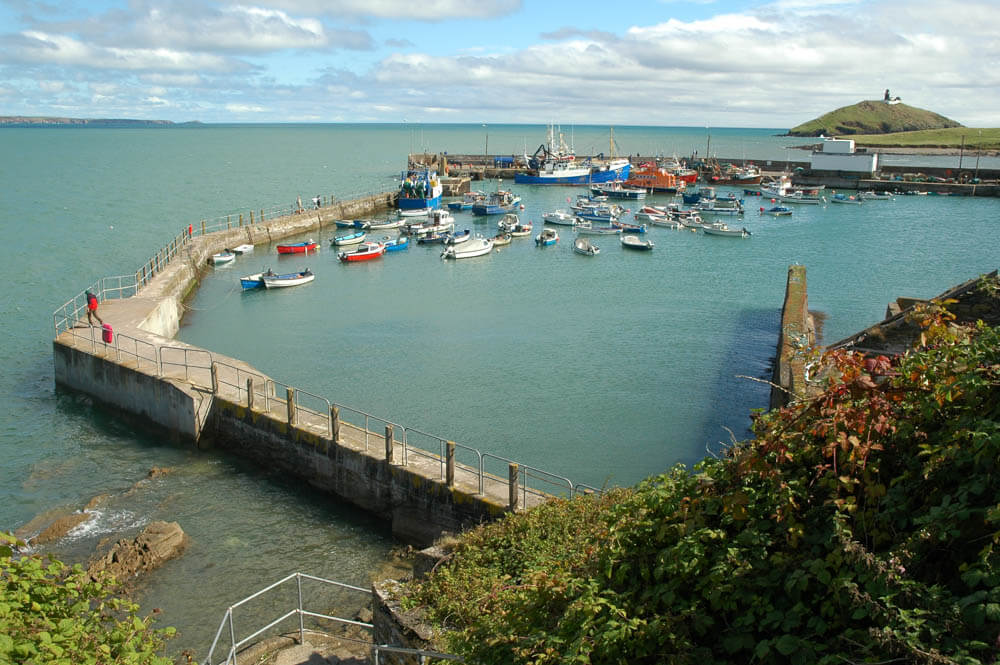
Peter is a master of these waters though with scores of years of experience, and he figured we’d have a half day window or so of opportunity before the real wind set in. Time enough to sample some of that quality ground fishing.
THE SESSION
Heading out past Ballycotton Island and the lighthouse the wind was breezy enough to start, but not building yet and the sea state was predictable with a light easy roll. The swell was there though, and widening, that foretold the blow coming in.
We elected to try a few drifts over clean sand first then drift over mixed ground to build up the species count. We were only a couple of miles out from the island, but the average depth was around 120ft.
We all chose small baited feather rigs with the aim to just “see what’s down there.” First in were Norm and Mike Jr with a small ling and a string of three fat whiting respectively. The whiting were thick down there, and not the thin looking fish you see so often on our side of the pond, but full bodied and healthy open Atlantic fish, some creeping towards a pound a half.
I bagged a single whiting, then dropped down straight in to fish again and brought up scad, mackerel and a little grey gurnard as a triple header. The other lads on board were also in to mackerel, whiting and the odd scad.
Moving on to the mixed ground the species count shot up. We all bagged poor cod, ling and small pollack. Norm, Mike Jr and I have fished together so long now we automatically fish as a team, each doing something different from the other to maximise the day’s potential. Mike Jnr went on a drift rig using a chrome spoon and started hitting gurnards one after the other, a nice haddock, small ling and pollack. Norm moved on to bigger fish baits trying to get a decent ling out, and Pete the skipper joined in showing us how to catch codling bagging a nice fish about 4lbs, followed by a decent sized grey gurnard.
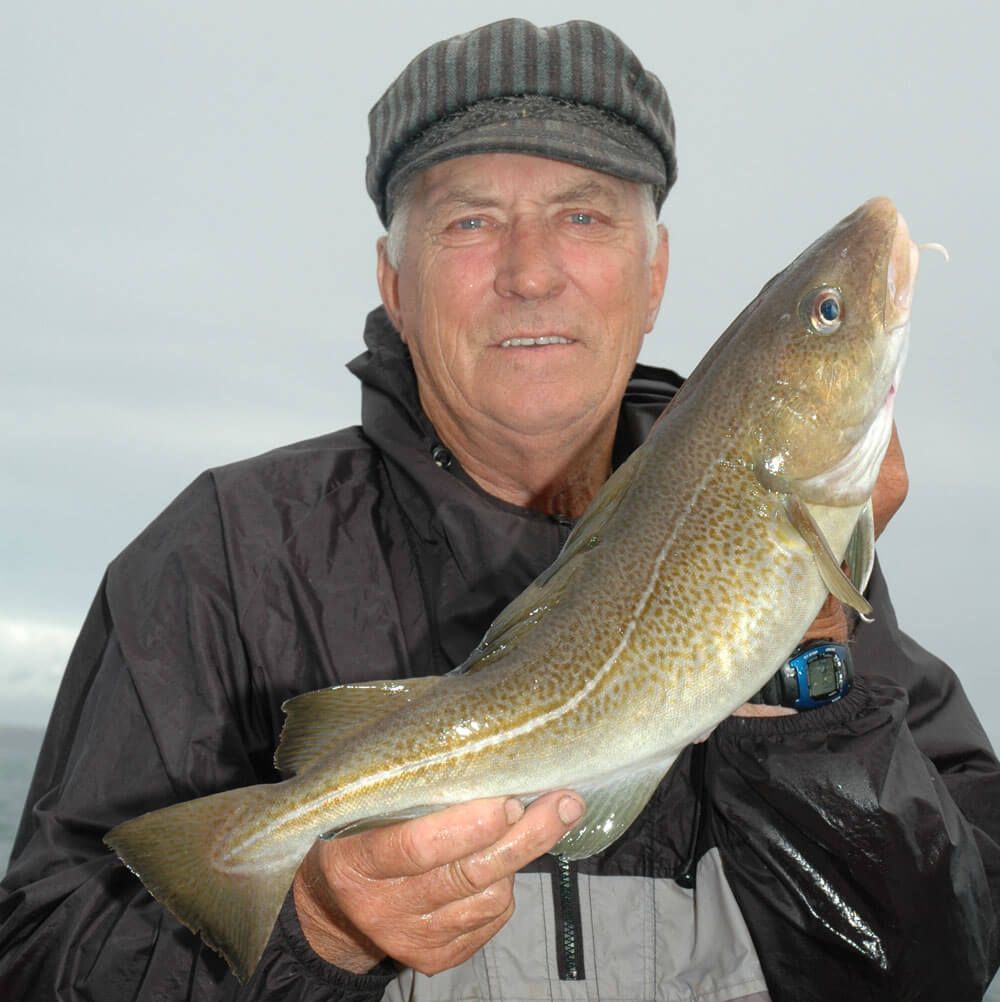
I fancied catching a few wrasse, so changed over to a different style of baited feathers again. Instantly I felt the “tap” “tap” of the little poor cod, but then the rapid rattle that signifies the bite of a cuckoo wrasse. This was a drab coloured female, but the next drop down I got a brightly coloured male cuckoo and a ballan wrasse as a double header.
Peter sidled up alongside me and said: “There’s a place I fancy trying that might just give us a shot of a decent sized pollack as the tide starts to run, but we’ll have to anchor.” That took no studying at all, and I learned from Pete that the area features rising rock pinnacles coming up off the seabed to a little over mid water depth.
Although I was at the stern of the boat, I chose not to fish a long flying collar rig, preferring to use a 12lb outfit with a lead headed lure tied direct to the main line. The water is very clear here in southern Ireland and in water around the 100ft mark a single lead head can pick out the bigger wiser fish better than when using a flying collar rig with the obvious boom leading the lure as it passes by.
I decided to carry on fishing for species, but with ever an eye on the other anglers, and as soon as the pollack switched on to feed, move over to working the lead head.
The other lads on board went on to bigger fish baits and started pulling in some nice double figure conger, the best just shy of 20lbs. Those fishing feathers also found some good codling, again to about 4lbs, plus numbers of smaller ling.
My lad had been steadily knocking fish out, then switched rigs and found some cracking pout, the best over 2lbs, in amongst the codling and small coalfish.
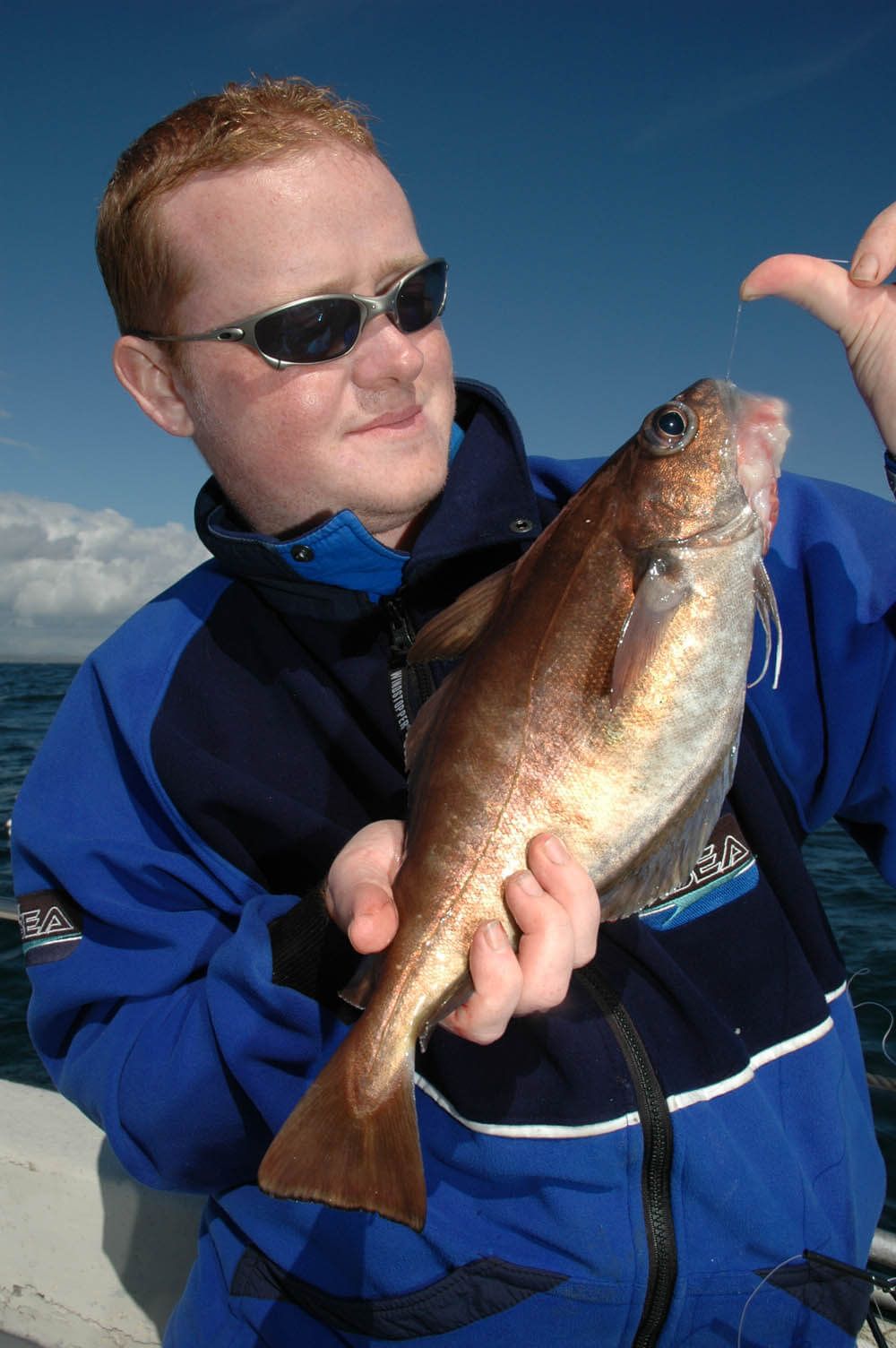
Peter had been working a lure for the pollack and started to pick up small fish around 2lbs. The tide was just starting to flood, so the bigger fish would not wait much longer before feeding.
10 minutes later I decided to switch over to working the lead head. I must have made 20 drops, touch the seabed, slow retrieve with occasional faster cranks of the reel handle to give some life to the lure, then something grabbed the lure and tried to crash dive. This was a small fish about 5lbs but an indicator the better fish had come on the feed.
I switched over to a bigger lead head in a mackerel colour with the idea of imitating the numbers of small joey mackerel that we’d been catching. A few drops later a big fish whacked the lure and steamed head first for the bottom. This fish had weight and used it wisely in the tide making me back the drag off a little more, but pumping the fish up through the water tables in between dives. The rod was hooped over and the fish could just be seen as colour below when the hook pulled out. Gutted…but I’ve been there many times before and the best bet is not to dwell on the loss, just get back down there and keep trying.
A short time later the lead head got whacked again. Straight for the seabed this fish went whipping line off the reel and hammering the rod tip. It came up another 15-yards then took the same line back again. That fish made three more stunning crash dives before I pumped it up to the surface where Peter netted the fish. It weighed just over 11lbs with the Irish specimen weight being only 12lbs.
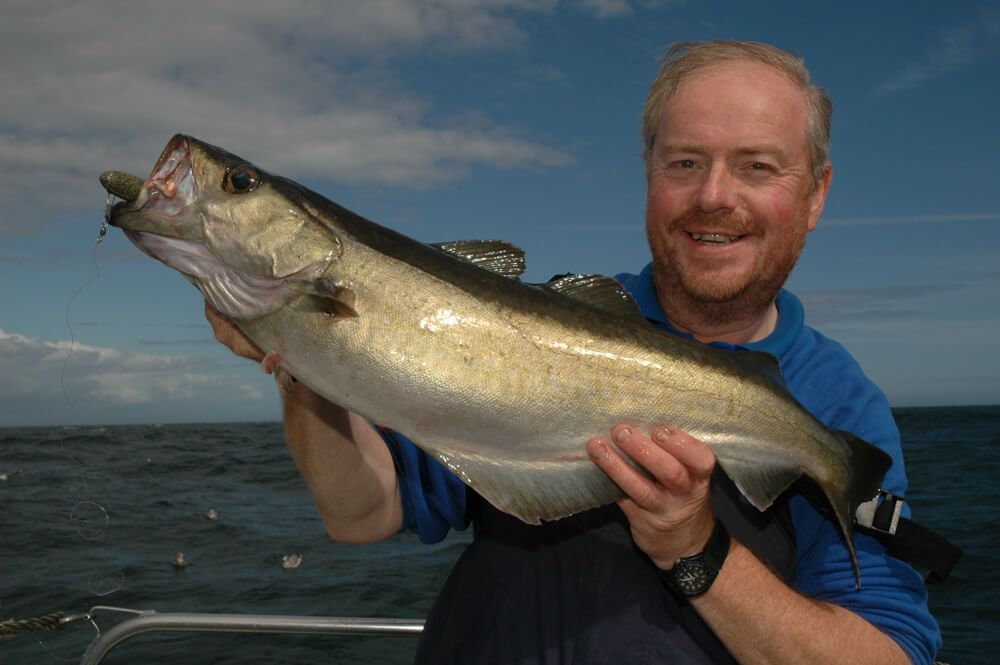
Now Mike Jr is a fast thinker, and he figured he’d switch to lures once he’d seen my fish hit the deck. He chose a Calcutta weighted shad lure and it took him just a couple of drops before he too had a fish slam in to the lure.
This was another good scrap and I’d already picked up the landing net and was waiting at the stern to net the fish for him. It was the same story, crash dive after crash dive on the light 12lb gear, and it took some real hard work on his part to pump the fish up in the water. It eventually broke surface and I scooped his prize up in the net. It was a dead ringer for the fish I’d just caught, another 11lb plus fish with the shad deep inside the mouth.
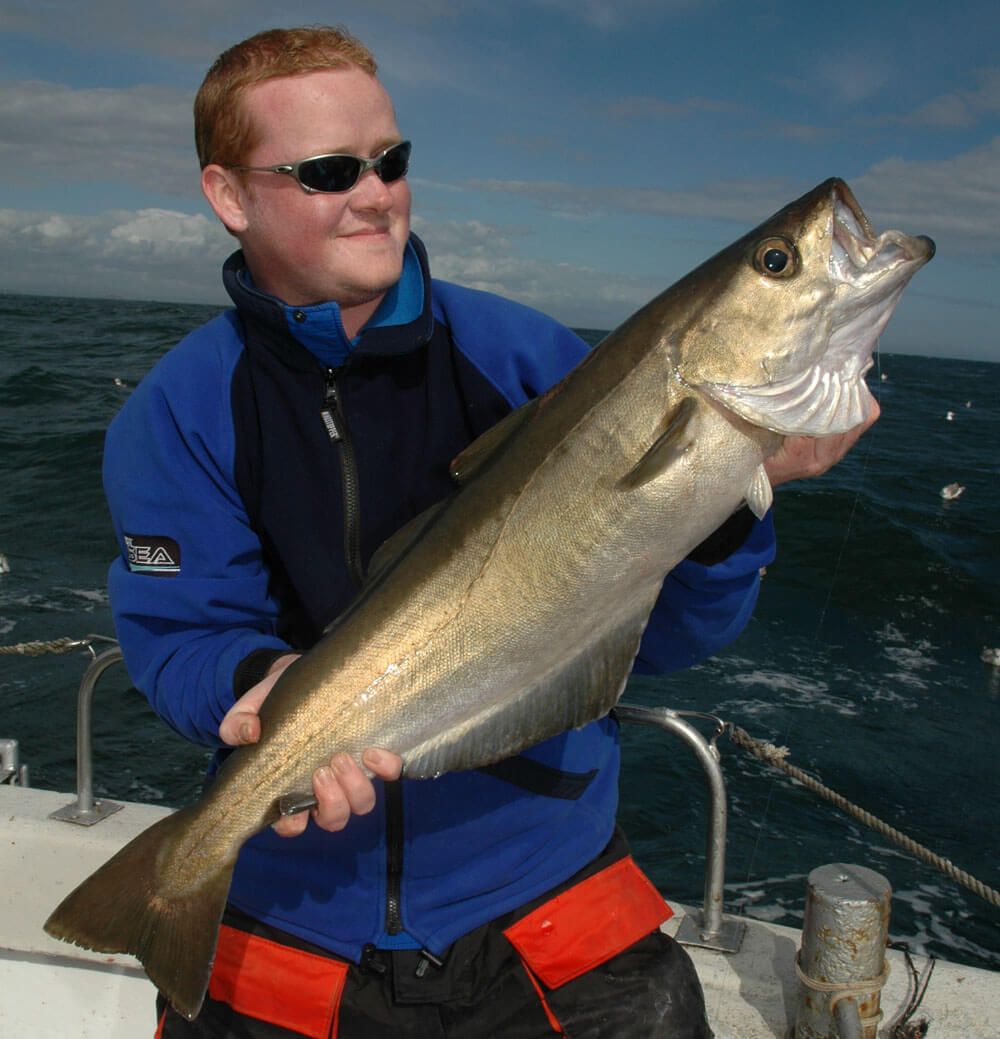
With the flooding tide the wind had picked up, though we were catching fish continuously and hadn’t noticed. Peter had though, and said that with the two good pollack it was time to hit the throttle for the sanctuary of the harbour.
Maybe 3 hours solid fishing and basically we’d had a cracking time! Rakes of smaller species, some good codling, big conger, plus the near specimen pollack, and all within a couple of miles of shore, and right before the teeth of an incoming gale too.
Just a couple of miles further out and there is good ling ground with reef fish to 20lbs, bigger conger, plus on the drift you’ll pick up double figure cod, good haddock, garfish, big red and tub gurnards, even hake, which I’ve witnessed myself caught by Peter. There’s also the possibility of the odd common skate, which nobody has fished for now for many years.
Ballycotton may not be that well known as Irish ports go with UK anglers, but it is one of the best ports with some of the very best fishing grounds, plus in Peter it has a skipper who knows how to fish it. It doesn’t get better than that!
TACKLE
For general drift fishing go for a 20 to 30lb class braid rod, but fish 25ft of 30lb mono below the braid as a “softener” to give the line a little stretch and to protect a light hook hold. Carry leads between 4ozs and 12ozs, rarely will you need more weight unless working much deeper water outside.
For the pollack a true UK 12lb class with a light tip, but progressive power in to a stiff butt section gives a good fight but has the power to lift big fish.
When anchored over the rough a 20lb class rod and reel is ideal for the reef conger and ling, though if you prefer a 30lb class will give you all the lifting power you’ll need. This 20lb class rod is also my typical choice for the blue sharks.
BAITS & LURES
We’ve found the Calcutta Flashfoil Swim Shads exceptional fish takers in Pearl Ice and mackerel green colours. Red, black and white Redgills, or the black jelly worms with the red tail also work well on flying collar rigs.
For drift fishing, try to source some of the green luminous plastic bodied eels with either the feather tails or the plastic muppet type tails. When baited with thin strips of white belly mackerel these are deadly for all the bottom living species.
The belly strips need to be about 4-inches long by a half inch wide to represent small sandeels and fish and move in the water as they drift along.
We also found size 2/0 to 4/0 Hokkeye’s with a semi luminous green feather type tail particularly effective for the wrasse and codling over this ground.
SHORE FISHING
There’s great shore fishing off the inner harbour wall into the bay for rays, plaice, sole, dabs, flounder and bass. Off the front wall you’ll take mackerel, scad, mullet, bass and mini species.
Also try fishing for the bass off the rocks to the right hand side of the harbour. I’ve seen 12lb bass taken here with crab or sandeel the best baits.
CHARTER SKIPPER
Peter Manning, The Farm, Church Road, Ballycotton, Co. Cork. Telephone: 00 353 21 4646773 or 00 353 86 8124922.
WHERE TO STAY
We chose to stay at the Sunville House Guesthouse, Ballycotton, Co Cork. Tel: 00 353 21 464 6271. E-mail: sunvillehouse@eircom.net. Sunville Guest House. There are also numerous B & B houses and Guesthouses in Ballycotton village.
If you prefer hotel accommodation there is the Bayview Hotel, Ballycotton overlooking the bay and harbour. Tel: 00 353 21 0646746.
Alternatively check out …www.tourismireland.com or request information from info@tourismireland.com . Also www.ireland.ie .
GENERAL INFORMATION
The Central Fisheries Board, Swords Business Camp, Swords, Co Dublin, Ireland. Tel: 00 353 1 8842 600 has a great website at www.cfb.ie. Click on Sea Fishing, then on Sea Fishing Maps For Ireland, and look at Co Cork and Ballycotton. In addition this site has masses of other useful information and practical fishing advice.
There are good pubs with food in Ballycotton, especially the Harbourside which on the walls has photos of many of the big skate and sharks that have been caught from local waters over the years.
Facing south and licked by the warm gulf stream to this day the waters still teem with fish and the general ground fishing is just about as good as it gets, plus you have a massive variety of species available from poor cod right up to blue sharks.
Mike Jr and I were to meet up with Norman Dunlop, Sea Angling Advisor to the Central Fisheries Board, for a day out with Pete Manning who runs the charter boat “Cleona” out from Ballycotton. I’d caught blue shark with Peter the year before and we wanted another crack at the beasties on really light gear and possibly to try and pick one up on fly gear, but the weather looked bad and the forecast that night ensured the sharks were out of bounds.

Peter is a master of these waters though with scores of years of experience, and he figured we’d have a half day window or so of opportunity before the real wind set in. Time enough to sample some of that quality ground fishing.
THE SESSION
Heading out past Ballycotton Island and the lighthouse the wind was breezy enough to start, but not building yet and the sea state was predictable with a light easy roll. The swell was there though, and widening, that foretold the blow coming in.
We elected to try a few drifts over clean sand first then drift over mixed ground to build up the species count. We were only a couple of miles out from the island, but the average depth was around 120ft.
We all chose small baited feather rigs with the aim to just “see what’s down there.” First in were Norm and Mike Jr with a small ling and a string of three fat whiting respectively. The whiting were thick down there, and not the thin looking fish you see so often on our side of the pond, but full bodied and healthy open Atlantic fish, some creeping towards a pound a half.
I bagged a single whiting, then dropped down straight in to fish again and brought up scad, mackerel and a little grey gurnard as a triple header. The other lads on board were also in to mackerel, whiting and the odd scad.
Moving on to the mixed ground the species count shot up. We all bagged poor cod, ling and small pollack. Norm, Mike Jr and I have fished together so long now we automatically fish as a team, each doing something different from the other to maximise the day’s potential. Mike Jnr went on a drift rig using a chrome spoon and started hitting gurnards one after the other, a nice haddock, small ling and pollack. Norm moved on to bigger fish baits trying to get a decent ling out, and Pete the skipper joined in showing us how to catch codling bagging a nice fish about 4lbs, followed by a decent sized grey gurnard.

I fancied catching a few wrasse, so changed over to a different style of baited feathers again. Instantly I felt the “tap” “tap” of the little poor cod, but then the rapid rattle that signifies the bite of a cuckoo wrasse. This was a drab coloured female, but the next drop down I got a brightly coloured male cuckoo and a ballan wrasse as a double header.
Peter sidled up alongside me and said: “There’s a place I fancy trying that might just give us a shot of a decent sized pollack as the tide starts to run, but we’ll have to anchor.” That took no studying at all, and I learned from Pete that the area features rising rock pinnacles coming up off the seabed to a little over mid water depth.
Although I was at the stern of the boat, I chose not to fish a long flying collar rig, preferring to use a 12lb outfit with a lead headed lure tied direct to the main line. The water is very clear here in southern Ireland and in water around the 100ft mark a single lead head can pick out the bigger wiser fish better than when using a flying collar rig with the obvious boom leading the lure as it passes by.
I decided to carry on fishing for species, but with ever an eye on the other anglers, and as soon as the pollack switched on to feed, move over to working the lead head.
The other lads on board went on to bigger fish baits and started pulling in some nice double figure conger, the best just shy of 20lbs. Those fishing feathers also found some good codling, again to about 4lbs, plus numbers of smaller ling.
My lad had been steadily knocking fish out, then switched rigs and found some cracking pout, the best over 2lbs, in amongst the codling and small coalfish.

Peter had been working a lure for the pollack and started to pick up small fish around 2lbs. The tide was just starting to flood, so the bigger fish would not wait much longer before feeding.
10 minutes later I decided to switch over to working the lead head. I must have made 20 drops, touch the seabed, slow retrieve with occasional faster cranks of the reel handle to give some life to the lure, then something grabbed the lure and tried to crash dive. This was a small fish about 5lbs but an indicator the better fish had come on the feed.
I switched over to a bigger lead head in a mackerel colour with the idea of imitating the numbers of small joey mackerel that we’d been catching. A few drops later a big fish whacked the lure and steamed head first for the bottom. This fish had weight and used it wisely in the tide making me back the drag off a little more, but pumping the fish up through the water tables in between dives. The rod was hooped over and the fish could just be seen as colour below when the hook pulled out. Gutted…but I’ve been there many times before and the best bet is not to dwell on the loss, just get back down there and keep trying.
A short time later the lead head got whacked again. Straight for the seabed this fish went whipping line off the reel and hammering the rod tip. It came up another 15-yards then took the same line back again. That fish made three more stunning crash dives before I pumped it up to the surface where Peter netted the fish. It weighed just over 11lbs with the Irish specimen weight being only 12lbs.

Now Mike Jr is a fast thinker, and he figured he’d switch to lures once he’d seen my fish hit the deck. He chose a Calcutta weighted shad lure and it took him just a couple of drops before he too had a fish slam in to the lure.
This was another good scrap and I’d already picked up the landing net and was waiting at the stern to net the fish for him. It was the same story, crash dive after crash dive on the light 12lb gear, and it took some real hard work on his part to pump the fish up in the water. It eventually broke surface and I scooped his prize up in the net. It was a dead ringer for the fish I’d just caught, another 11lb plus fish with the shad deep inside the mouth.

With the flooding tide the wind had picked up, though we were catching fish continuously and hadn’t noticed. Peter had though, and said that with the two good pollack it was time to hit the throttle for the sanctuary of the harbour.
Maybe 3 hours solid fishing and basically we’d had a cracking time! Rakes of smaller species, some good codling, big conger, plus the near specimen pollack, and all within a couple of miles of shore, and right before the teeth of an incoming gale too.
Just a couple of miles further out and there is good ling ground with reef fish to 20lbs, bigger conger, plus on the drift you’ll pick up double figure cod, good haddock, garfish, big red and tub gurnards, even hake, which I’ve witnessed myself caught by Peter. There’s also the possibility of the odd common skate, which nobody has fished for now for many years.
Ballycotton may not be that well known as Irish ports go with UK anglers, but it is one of the best ports with some of the very best fishing grounds, plus in Peter it has a skipper who knows how to fish it. It doesn’t get better than that!
TACKLE
For general drift fishing go for a 20 to 30lb class braid rod, but fish 25ft of 30lb mono below the braid as a “softener” to give the line a little stretch and to protect a light hook hold. Carry leads between 4ozs and 12ozs, rarely will you need more weight unless working much deeper water outside.
For the pollack a true UK 12lb class with a light tip, but progressive power in to a stiff butt section gives a good fight but has the power to lift big fish.
When anchored over the rough a 20lb class rod and reel is ideal for the reef conger and ling, though if you prefer a 30lb class will give you all the lifting power you’ll need. This 20lb class rod is also my typical choice for the blue sharks.
BAITS & LURES
We’ve found the Calcutta Flashfoil Swim Shads exceptional fish takers in Pearl Ice and mackerel green colours. Red, black and white Redgills, or the black jelly worms with the red tail also work well on flying collar rigs.
For drift fishing, try to source some of the green luminous plastic bodied eels with either the feather tails or the plastic muppet type tails. When baited with thin strips of white belly mackerel these are deadly for all the bottom living species.
The belly strips need to be about 4-inches long by a half inch wide to represent small sandeels and fish and move in the water as they drift along.
We also found size 2/0 to 4/0 Hokkeye’s with a semi luminous green feather type tail particularly effective for the wrasse and codling over this ground.
SHORE FISHING
There’s great shore fishing off the inner harbour wall into the bay for rays, plaice, sole, dabs, flounder and bass. Off the front wall you’ll take mackerel, scad, mullet, bass and mini species.
Also try fishing for the bass off the rocks to the right hand side of the harbour. I’ve seen 12lb bass taken here with crab or sandeel the best baits.
CHARTER SKIPPER
Peter Manning, The Farm, Church Road, Ballycotton, Co. Cork. Telephone: 00 353 21 4646773 or 00 353 86 8124922.
WHERE TO STAY
We chose to stay at the Sunville House Guesthouse, Ballycotton, Co Cork. Tel: 00 353 21 464 6271. E-mail: sunvillehouse@eircom.net. Sunville Guest House. There are also numerous B & B houses and Guesthouses in Ballycotton village.
If you prefer hotel accommodation there is the Bayview Hotel, Ballycotton overlooking the bay and harbour. Tel: 00 353 21 0646746.
Alternatively check out …www.tourismireland.com or request information from info@tourismireland.com . Also www.ireland.ie .
GENERAL INFORMATION
The Central Fisheries Board, Swords Business Camp, Swords, Co Dublin, Ireland. Tel: 00 353 1 8842 600 has a great website at www.cfb.ie. Click on Sea Fishing, then on Sea Fishing Maps For Ireland, and look at Co Cork and Ballycotton. In addition this site has masses of other useful information and practical fishing advice.
There are good pubs with food in Ballycotton, especially the Harbourside which on the walls has photos of many of the big skate and sharks that have been caught from local waters over the years.

